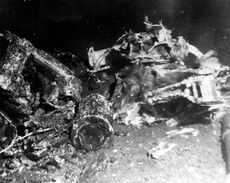Engineering:Nimbus B
From HandWiki
Short description: U.S. meteorological satellite, lost in a launch failure
| Mission type | Weather satellite |
|---|---|
| Operator | NASA |
| COSPAR ID | NIMBS-B |
| Mission duration | Launch failure |
| Spacecraft properties | |
| Manufacturer | RCA Astrospace |
| Launch mass | 571.5 kilograms (1,260 lb)[1] |
| Start of mission | |
| Rocket | Thorad-SLV2G Agena-D |
| Launch site | Vandenberg Air Force Base SLC-2E |
| Orbital parameters | |
| Reference system | Geocentric |
| Regime | Low Earth |
| Epoch | Planned[1] |
Nimbus B was a meteorological satellite launched as part of the Nimbus program. It was released on May 18, 1968 from the Vandenberg Air Force Base , Lompoc, California, by means of a Thor-Agena launch vehicle, together with the SECOR 10 satellite. Nimbus B never achieved orbit because a malfunction in the booster guidance system forced the destruction of the spacecraft and its payload during launch.
The Radioisotope Thermoelectric Generator SNAP-19 RTG was salvaged from the water, refurbished and later flown on Nimbus 3.[2]

Intact SNAP-19 fuel capsule is shown among debris on Pacific Ocean floor, resulting from the aborted launch of a Nimbus B.
Instruments
- High Data Rate Storage System (DHRSS)
- High and Medium-Resolution Infrared Radiometers (HRIR/MRIR)
- Image Dissector Camera System (IDCS)
- Infrared Interferometer Spectrometer (IRIS)
- Monitor of Ultraviolet Solar Energy (MUSE)
- Radioisotope Thermoelectric Generator (SNAP-19)
- Real-time transmission System (RTTS)
- Satellite Infrared Spectrometer (SIRS)
See also
References
- ↑ 1.0 1.1 "Nimbus B". National Space Science Data Center Master Catalog. NASA Goddard Space Flight Center. https://nssdc.gsfc.nasa.gov/nmc/spacecraft/display.action?id=NIMBS-B.
 This article incorporates text from this source, which is in the public domain.
This article incorporates text from this source, which is in the public domain.
- ↑ "Nimbus B". NASA Goddard Space Flight Center. https://nssdc.gsfc.nasa.gov/nmc/spacecraft/display.action?id=NIMBS-B.
 |

